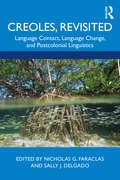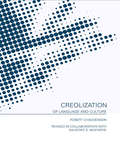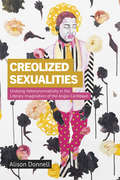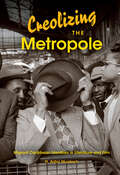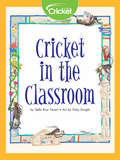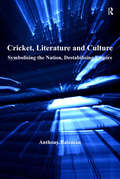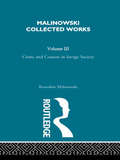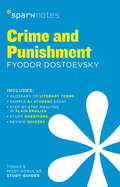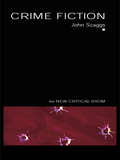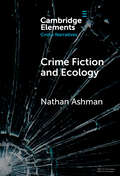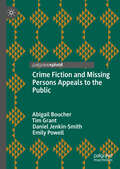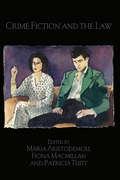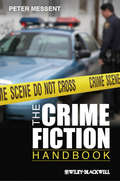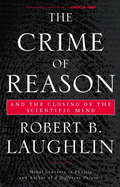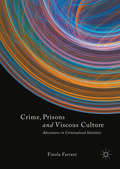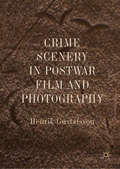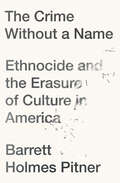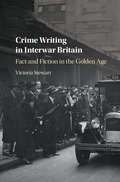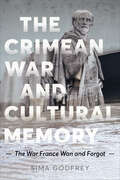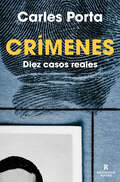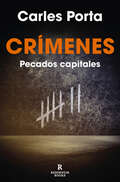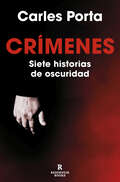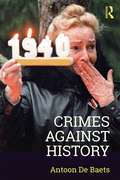- Table View
- List View
Creoles, Revisited: Language Contact, Language Change, and Postcolonial Linguistics
by Nicholas G. Faraclas and Sally J. DelgadoThis innovative book contributes to a paradigm shift in the study of creole languages, forging new empirical frameworks for understanding language and culture in sociohistorical contact. The authors bring together archival sources to challenge dominant linguistic theory and practice and engage issues of power, positioning marginalized indigenous peoples as the center of, and vital agents in, these languages’ formation and development. Students in language contact, pidgins and creoles, Caribbean studies, and postcolonial studies courses—and scholars across many disciplines—will benefit from this book and be convinced of the importance of understanding creoles and creolization.
Creolization of Language and Culture
by Robert ChaudensonCreolization of Language and Culture is the first English edition of Robert Chaudenson's landmark text Des îles, des hommes, des langues, which has also been fully revised.. With reference to the main varieties of creole French, Chaudenson argues against the traditional account of creole genesis for a more sophisticated paradigm which takes full account of the peculiar linguistic and social factors at play in colonial societies.This is an accessible book which makes an important contribution to the study of pidgin and creole language varieties, as well as to the development of contemporary European languages outside Europe. Key features include:Analysis of current debates on the development of creolesDiscussion of many aspects of human culture including music, medicine, cooking, magic and folkloreTranslation of all French sources from which Chaudenson quotes extensively
Creolized Sexualities: Undoing Heteronormativity in the Literary Imagination of the Anglo-Caribbean (Critical Caribbean Studies)
by Alison DonnellCreolized Sexualities: Undoing Heteronormativity in the Literary Imagination of the Anglo-Caribbean draws attention to a wide, and surprising, range of writings that craft inclusive and pluralizing representations of sexual possibilities within the Caribbean imagination. Reading across an eclectic range of writings from V.S. Naipaul to Marlon James, Shani Mootoo to Junot Diaz, Andrew Salkey to Thomas Glave, Curdella Forbes to Colin Robinson, this bold work of literary criticism brings into view fictional worlds where Caribbeanness and queerness correspond and reconcile. Through inspired close readings Donnell gathers evidence and argument for the Caribbean as an exemplary creolized ecology of fluid possibilities that can illuminate the prospect of a non-heteronormalizing future. Indeed, Creolized Sexualities hows how writers have long rendered sexual plasticity, indeterminacy, and pluralism as an integral part of Caribbeanness and as one of the most compelling if unacknowledged ways of resisting the disciplining regimes of colonial and neocolonial power.
Creolizing the Metropole: Migrant Caribbean Identities In Literature And Film (Blacks In The Diaspora Ser.)
by H. Adlai MurdochCreolizing the Metropole is a comparative study of postwar West Indian migration to the former colonial capitals of Paris and London. It studies the effects of this population shift on national and cultural identity and traces the postcolonial Caribbean experience through analyses of the concepts of identity and diaspora. Through close readings of selected literary works and film, H. Adlai Murdoch explores the ways in which these immigrants and their descendants represented their metropolitan identities. Though British immigrants were colonial subjects and, later, residents of British Commonwealth nations, and the French arrivals from the overseas departments were citizens of France by law, both groups became subject to otherness and exclusion stemming from their ethnicities. Murdoch examines this phenomenon and the questions it raises about borders and boundaries, nationality and belonging.
Creolizing the Modern: Transylvania across Empires
by Anca Parvulescu Manuela BoatcăHow are modernity, coloniality, and interimperiality entangled? Bridging the humanities and social sciences, Anca Parvulescu and Manuela Boatcă provide innovative decolonial perspectives that aim to creolize modernity and the modern world-system. Historical Transylvania, at the intersection of the Habsburg Empire, the Ottoman Empire, Austria-Hungary, and Russia, offers the platform for their multi-level reading of the main themes in Liviu Rebreanu's 1920 novel Ion. Topics range from the question of the region's capitalist integration to antisemitism and the enslavement of Roma to multilingualism, gender relations, and religion. Creolizing the Modern develops a comparative method for engaging with areas of the world that have inherited multiple, conflicting imperial and anti-imperial histories.
Cricket in the Classroom
by Della Ross FerreriNick and Emily chase a cricket around their classroom.
Cricket, Literature and Culture: Symbolising the Nation, Destabilising Empire
by Anthony BatemanIn his important contribution to the growing field of sports literature, Anthony Bateman traces the relationship between literary representations of cricket and Anglo-British national identity from 1850 to the mid 1980s. Examining newspaper accounts, instructional books, fiction, poetry, and the work of editors, anthologists, and historians, Bateman elaborates the ways in which a long tradition of literary discourse produced cricket's cultural status and meaning. His critique of writing about cricket leads to the rediscovery of little-known texts and the reinterpretation of well-known works by authors as diverse as Neville Cardus, James Joyce, the Great War poets, and C.L.R. James. Beginning with mid-eighteenth century accounts of cricket that provide essential background, Bateman examines the literary evolution of cricket writing against the backdrop of key historical moments such as the Great War, the 1926 General Strike, and the rise of Communism. Several case studies show that cricket simultaneously asserted English ideals and created anxiety about imperialism, while cricket's distinctively colonial aesthetic is highlighted through Bateman's examination of the discourse surrounding colonial cricket tours and cricketers like Prince Kumar Shri Ranjitsinhji of India and Sir Learie Constantine of Trinidad. Featuring an extensive bibliography, Bateman's book shows that, while the discourse surrounding cricket was key to its status as a symbol of nation and empire, the embodied practice of the sport served to destabilise its established cultural meaning in the colonial and postcolonial contexts.
Crime and Custom in Savage Society: [1926/1940] (Quality Paperback Ser. #No. 210)
by Bronislaw MalinowskiThis volume discusses aspects of small scale societies, including the study of the mental processes, as well as indigenous economics and law.
Crime and Local Television News: Dramatic, Breaking, and Live From the Scene (Routledge Communication Series)
by Jeremy H. Lipschultz Michael L. HiltThis volume offers an analysis of crime coverage on local television, exploring the nature of local television news and the ongoing appeal of crime stories. Drawing on the perspectives of media studies, psychology, sociology, and criminology, authors Jeremy H. Lipschultz and Michael L. Hilt focus on live local television coverage of crime and examine its irresistibility to viewers and its impact on society's perceptions of itself. They place local television news in its theoretical and historical contexts, and consider it through the lens of legal, ethical, racial, aging, and technological concerns. In its comprehensive examination of how local television newsrooms around the country address coverage of crime, this compelling work discusses such controversial issues as the use of crime coverage to build ratings, and considers new models for reform of local TV newscasts. The volume includes national survey data from news managers and content analyses from late night newscasts in a range of markets, and integrates the theory and practice of local television news into the discussion. Lipschultz and Hilt also project the future of local television news and predict the impact of social and technological changes on news. As a provocative look at the factors and forces shaping local news and crime coverage, Crime and Local Television News makes an important contribution to the discussions taking place in broadcast journalism, mass communication, media and society, and theory and research courses. It will also interest all who consider the impact of local news content and coverage.
Crime and Punishment SparkNotes Literature Guide (SparkNotes Literature Guide Series #23)
by SparkNotesCrime and Punishment SparkNotes Literature Guide by Fyodor Dostoevsky Making the reading experience fun! When a paper is due, and dreaded exams loom, here's the lit-crit help students need to succeed! SparkNotes Literature Guides make studying smarter, better, and faster. They provide chapter-by-chapter analysis; explanations of key themes, motifs, and symbols; a review quiz; and essay topics. Lively and accessible, SparkNotes is perfect for late-night studying and paper writing. Includes:An A+ Essay—an actual literary essay written about the Spark-ed book—to show students how a paper should be written.16 pages devoted to writing a literary essay including: a glossary of literary termsStep-by-step tutoring on how to write a literary essayA feature on how not to plagiarize
Crime Fiction (The New Critical Idiom)
by John ScaggsCrime Fiction provides a lively introduction to what is both a wide-ranging and hugely popular literary genre. Using examples from a variety of novels, short stories, films and televisions series, John Scaggs: presents a concise history of crime fiction - from biblical narratives to James Ellroy - broadening the genre to include revenge tragedy and the gothic novel explores the key sub-genres of crime fiction, such as 'Rational Criminal Investigation', The Hard-Boiled Mode', 'The Police Procedural' and 'Historical Crime Fiction' locates texts and their recurring themes and motifs in a wider social and historical context outlines the various critical concepts that are central to the study of crime fiction, including gender, narrative theory and film theory considers contemporary television series like C.S.I.: Crime Scene Investigation alongside the 'classic' whodunnits of Agatha Christie. Accessible and clear, this comprehensive overview is the essential guide for all those studying crime fiction and concludes with a look at future directions for the genre in the twentieth-first century.
Crime Fiction and Ecology: From the Local to the Global (Elements in Crime Narratives)
by Nathan AshmanThis Element examines how contemporary ecological crime narratives are responding to the scales and complexities of the global climate crisis. It opens with the suggestion that there are certain formal limits to the genre's capacity to accommodate and interrogate these multifaceted dynamics within its typical stylistic and thematic bounds. Using a comparative methodological approach that draws connections and commonalities between literary crime texts from across a range of geographical locales – including works from Asia, Europe, Africa, South America, North America and Oceana – it therefore seeks to uncover examples of world crime fictions that are cultivating new forms of environmental awareness through textual strategies capable of conceiving of the planet as a whole. This necessitates a movement away from considering crime fictions in the context of their distinct and separate national literary traditions, instead emphasising the global and transnational connections between works.
Crime Fiction and Missing Persons Appeals to the Public
by Abigail Boucher Tim Grant Daniel Jenkin-Smith Emily PowellThis book draws upon genre fiction studies, forensic linguistics, and media studies to investigate the overlap between crime fiction conventions and the writing of missing persons appeals to the public. This book is based on a pilot project funded by the Aston Institute for Forensic Linguistics, entitled 'Genre, Pacing, and Narrative in Police Missing Persons Appeals' (Aug 2021-Nov 2022). The authors identify a missing persons appeal as a literary and linguistic genre in its own right and illustrate the problems that arise when the appeals writing process goes unregulated or unstudied: there is currently little-to-no official, national police guidance, regulation, or standard procedure for writing a missing persons appeal in the UK. The authors also identify opportunities for improving the writing and delivery of appeals by further (and more intentionally) applying crime fiction conventions, narrative devices, and pacing, to maximise audience reach and increase the chances of recovering a missing person. This book will be of particular interest to genre fiction scholars (particularly those interested in crime fiction), forensic linguists, and media studies scholars.
Crime Fiction and the Law (Birkbeck Law Press)
by Maria Aristodemou Fiona Macmillan Patricia TuittThis book opens up a range of important perspectives on law and violence by considering the ways in which their relationship is formulated in literature, television and film. Employing critical legal theory to address the relationship between crime fiction, law and justice, it considers a range of topics, including: the relationship between crime fiction, legal reasoning and critique; questions surrounding the relationship between law and justice; gender issues; the legal, political and social impacts of fictional representations of crime and justice; post-colonial perspectives on crime fiction; as well as the impact of law itself on the crime fiction’s development. Introducing a new sub-field of legal and literary research, this book will be of enormous interest to scholars in critical, cultural and socio-legal studies, as well as to others in criminology, as well as in literature.
The Crime Fiction Handbook
by Peter MessentThe Crime Fiction Handbook presents a comprehensive introduction to the origins, development, and cultural significance of the crime fiction genre, focusing mainly on American British, and Scandinavian texts. Provides an accessible and well-written introduction to the genre of crime fiction Moves with ease between a general overview of the genre and useful theoretical approaches Includes a close analysis of the key texts in the crime fiction tradition Identifies what makes crime fiction of such cultural importance and illuminates the social and political anxieties at its heart. Shows the similarities and differences between British, American, and Scandinavian crime fiction traditions
The Crime of Reason: And the Closing of the Scientific Mind
by Laughlin Robert B.We all agree that the free flow of ideas is essential to creativity. And we like to believe that in our modern, technological world, information is more freely available and flows faster than ever before. But according to Nobel Laureate Robert Laughlin, acquiring information is becoming a danger or even a crime. Increasingly, the really valuable information is private property or a state secret, with the result that it is now easy for a flash of insight, entirely innocently, to infringe a patent or threaten national security. The public pays little attention because this vital information is "technical”--but, Laughlin argues, information is often labeled technical so it can be sequestered, not sequestered because it’s technical. The increasing restrictions on information in such fields as cryptography, biotechnology, and computer software design are creating a new Dark Age: a time characterized not by light and truth but by disinformation and ignorance. Thus we find ourselves dealing more and more with the Crime of Reason, the antisocial and sometimes outright illegal nature of certain intellectual activities. The Crime of Reason is a reader-friendly jeremiad, On Bullshit for the Slashdot and Creative Commons crowd: a short, fiercely argued essay on a problem of increasing concern to people at the frontiers of new ideas.
Crime, Prisons and Viscous Culture: Adventures in Criminalized Identities
by Finola FarrantThis unique book explores criminalized identities and the idea of 'viscous culture' to provide new understandings of crime, punishment and justice. It shows that viscous culture encourages some of us to become outlaws, monsters or shapeshifters who challenge systems of domination and forces of control. Crime, Prisons and Viscous Culture interweaves analyses of popular culture with extensive empirical research to explore both the glamorous and grotesque nature of crime, control and containment. Through encounters with numerous popular and mythological archetypes the book explores the boundaries of the criminological discipline. Criminology itself is presented as fragmented, distorted and fascinating, and the important transdisciplinary potential of criminology is highlighted. In doing so, this book will be of great interest to scholars of criminology, cultural studies, popular culture and sociological theory.
Crime Scenery in Postwar Film and Photography
by Henrik GustafssonThis book offers a rare and innovative consideration of an enduring tendency in postwar art to explore places devoid of human agents in the wake of violent encounters. To see the scenery together with the crime elicits a double interrogation, not merely of a physical site but also of its formation as an aesthetic artefact, and ultimately of our own acts of looking and imagining. Closely engaging with a vast array of works made by artists, filmmakers and photographers, each who has forged a distinct vantage point on the aftermath of crime and conflict, the study selectively maps the afterlife of landscape in search of the political and ethical agency of the image. By way of a thoroughly interdisciplinary approach, Crime Scenery in Postwar Film and Photography brings landscape studies into close dialogue with contemporary theory by paying sustained attention to how the gesture of retracing past events facilitates new configurations of the present and future.
The Crime Without a Name: Ethnocide and the Erasure of Culture in America
by Barrett Holmes PitnerIn this incisive blend of personal narrative and philosophical inquiry, journalist and activist Barrett Holmes Pitner seeks a new way to talk about racism in America.Can new language reshape our understanding of the past and expand the possibilities of the future? The Crime Without a Name follows Pitner&’s journey to identify and remedy the linguistic void in how we discuss race and culture in the United States. Ethnocide, first coined in 1944 by Jewish exile Raphael Lemkin (who also coined the term "genocide"), describes the systemic erasure of a people&’s ancestral culture. For Black Americans, who have endured this atrocity for generations, this erasure dates back to the transatlantic slave trade and reached new resonance in a post-Trump world. Just as the concept of genocide radically reshaped our perception of human rights in the twentieth century, reframing discussions about race and culture in terms of ethnocide can change the way we understand our diverse and rapidly evolving racial and political climate in a time of increased visibility around police brutality and systemic racism. The Crime Without a Name traces the historical origins of ethnocide in the United States, examines the personal, lived consequences of existing within an ongoing erasure, and offers ways for readers to combat and overcome our country&’s ethnocidal foundation.
Crime Writing in Interwar Britain: Fact and Fiction in the Golden Age
by Victoria StewartThe interwar period is often described as the 'Golden Age' of detective fiction, but many other kinds of crime writing, both factual and fictional, were also widely read during these years. Crime Writing in Interwar Britain: Fact and Fiction in the Golden Age considers some of this neglected material in order to provide a richer and more complex view of how crime and criminality were understood between the wars. A number of the authors discussed, including Dorothy L. Sayers, Marie Belloc Lowndes and F. Tennyson Jesse, wrote about crime in essays, book reviews, newspaper articles and works of popular criminology, as well as in novels and short stories. Placing debates about detective fiction in the context of this largely forgotten but rich and diverse culture of writing about crime will give a unique new picture of how criminality and the legal process were considered at this time.
The Crimean War and Cultural Memory: The War France Won and Forgot
by Sima GodfreyThe Crimean War (1854–56) is widely considered the first modern war with its tactical use of railways, telegraphs, and battleships, its long-range rifles, and its notorious trenches – precursors of the Great War. It is also the first media war: the first to know the impact of a correspondent on the field of battle and the first to be documented in photographs. No one, however, including the French themselves, seems to remember that France was there, fighting in Crimea, losing 95,000 soldiers and leading the Allied campaign to victory. It would seem that the Crimean War has no place in the canon of culturally retained historical events that define modern French identity. Looking at literature, art, theatre, material objects, and medical reports, The Crimean War and Cultural Memory considers how the Crimean War was and was not represented in French cultural history in the second half of the nineteenth century. Ultimately, the book illuminates the forgotten traces that the Crimean War left on the French cultural landscape.
Crímenes: Diez casos reales
by Carles Porta*****INCREÍBLEMENTE REAL***** El periodismo literario de Carles Porta sigue la estela de Ferdinand von Schirach y Patrick Radden Keefe. Carles Porta probablemente sea uno de nuestros mejores periodistas, pero sin duda se ha coronado, con sus libros, podcasts y series televisivas, como un magistral narrador de relatos reales. En este volumen, que recoge diez de los casos más impactantes de la crónica negra reciente, descubriremos su especialidad literaria: contarnos extraordinarias historias de crimen y trabajo policial mientras nos mantiene en vilo hasta la última línea. La fórmula puede parecer sencilla, pero él la convierte en inimitable gracias al tratamiento riguroso que hace de los grandes personajes que escoge y la manera en que los sabe envolver en tramas tan potentes como verídicas. Aquí encontraremos, entre otros: el caso de Amaia Azkue, la vecina de Zarautz cuyo asesino fue identificado por un detalle trivial; la estremecedora desaparición de los hermanos Òrrit en el hospital de Manresa y la búsqueda que ha llevado a cabo durante décadas su numerosa familia; el asesinato a sangre fría de un hombre en Madrid a causa de un macabro juego de rol; o el sangriento robo que cometió una mujer en Fargo, Dakota del Norte, contra su propia vecina. La crítica ha dicho:«El rey de la crónica negra en España.»El Mundo «Un profundo ejercicio de depuración de estilo.»ABC «Periodismo en profundidad, y próximo.»La Vanguardia «Combina el rigor y el entretenimiento sin caer en la tentación del morbo ni tampoco rehuir los anzuelos para propulsar la lectura.»El País La crítica ha dicho sobre La farmacéutica:«Se lee todo del tirón y uno no da crédito a que sucediera de verdad. [...] Crónica definitiva de aquel secuestro, es un libro de lectura muy dinámica.»El Mundo «Lo que realmente le gusta a Porta es contar buenas historias. [...] La última es un clásico de 1992, tiene como protagonista a una farmacéutica y la cuenta en un gran libro.»La Vanguardia «Un solo hilo narrativo que combina la vivacidad, el drama y la ironía, además de evidenciar la grandeza y, a su vez, la miseria humana. [...] Sin duda, con esta crónica, Porta se consagra, según los expertos del género, como un maestro del periodismo narrativo.»NacióDigital «Este libro pone orden y claridad a los acontecimientos: Porta narra con dinamismo y rellena todos los agujeros con tal de revertir los malentendidos que circulan en la esfera pública.»El País «Una crónica trepidante.»ABC «Una especie de Fargo en la Garrotxa.»Diari de Girona
Crímenes: pecados capitales
by Carles PortaVuelve Carles Porta, el creador de ¿Por qué matamos? y Crims/Crímenes,con su formato más adictivo: los crímenes reales más increíbles,como jamás te los han contado. «Combina el rigor y el entretenimiento sin caer en la tentación del morbo ni tampoco rehuir los anzuelos para propulsar la lectura».El País «El rey de la crónica negra en España».El Mundo Soberbia, avaricia, lujuria, ira, gula, envidia y pereza. Los siete pecados capitales. Descritos por Dante en la Divina comedia. Señalados por la tradición eclesiástica cristiana como el origen de los demás vicios. Son, sin duda, lacras que desde tiempos inmemoriales han arraigado en nuestra mente. ¿Podríamos imaginar al ser humano sin ellas? ¿Son estas las pasiones que mueven el mundo en que vivimos? ¿Por qué matamos? Las siete historias reales que leeréis tienen alguna de estas pasiones del alma como móvil del crimen: el secuestro de Mélodie Nakachian, en el ámbito de la jet set de la Costa del Sol en los años ochenta; el crimen del supermercado Esclat de Mollet del Vallès, con el apuñalamiento ensañado a un guardia de seguridad; la desaparición del bebé de una familia de Canovelles, cerca de Granollers, a la que poco antes había tocado el Gordo de Navidad; el caso Febamar en Alcanar, en el extremo sur de Catalunya, donde el propietario de un concesionario de coches y su mujer fueron víctimas de un asalto mortal; la crónica de cómo una intervención policial ordinaria destapó la tragedia siniestra del caníbal de Ventas, en Madrid; la historia del monje shaolín de Bilbao, que había convertido su gimnasio en un pozo de los horrores; y el asesinato, cerca de Figueres, de Isidre Matas, un hombre con muy mala suerte. La crítica ha dicho:«Un profundo ejercicio de depuración de estilo».ABC «Periodismo en profundidad, y próximo».La Vanguardia Sobre Crímenes. Diez casos reales:«Su especialidad literaria: contarnos extraordinarias historias de crimen y trabajo policial mientras nos mantiene en vilo hasta la última línea».La Razón«La crónica negra de toda la vida pero narrada como nunca».ABC «Un auténtico maestro en el arte de contar casos [...] siempre riguroso y prestando atención a todas las aristas, ya sean estas psicológicas, sociales, políticas o culturales. Historias inverosímiles que nunca creeríamos si no supiéramos que ocurrieron realmente».Men's HealthSobre La farmacéutica: «Se lee todo del tirón y uno no da crédito a que sucediera de verdad. [...] Crónica definitiva de aquel secuestro, es un libro de lectura muy dinámica».El Mundo «Este libro pone orden y claridad a los acontecimientos: Porta narra con dinamismoy rellena todos los agujeros con tal de revertir los malentendidos que circulan en la esfera pública».El País «Una especie de Fargo en la Garrotxa».Diari de Girona
Crímenes. Siete historias de oscuridad: Incluye el crimen de la Guardia Urbana (Crímenes #Volumen 1)
by Carles PortaLos crímenes reales más increíbles, como jamás te los han contado.Por el creador de ¿Por qué matamos? y Crims/Crímenes ***INCLUYE EL CRIMEN DE LA GUARDIA URBANA*** Carles Porta es el narrador de crímenes más singular del panorama nacional. Sus historias son estremecedoras sin amarillismo, frías pero delicadas, apasionantes sin caer en lo morboso. En este volumen se reúnen siete crónicas narradas con ritmo experto y rigor documental, la marca del éxito de su autor.Entre ellas, destacan el crimen de la Viuda Negra de L’Hospitalet, que en los años noventa fue definida como «la asesina en serie por envenenamiento más importante de la historia criminal española»; el caso del rico informático catalán descuartizado en Bangkok; la historia del camionero alemán que, en sus viajes por Europa, fue dejando un rastro de muerte a largo de veinte países; o el célebre caso de la Guardia Urbana, en el que las intrincadas declaraciones de los protagonistas van conformado un relato donde la realidad supera a la ficción.Como colofón, esta edición incluye también los guiones completos de la miniserie El Crimen de la Guardia Urbana, emitida en TV3 y Movistar+, donde asistimos al desenlace final de uno de los sucesos más mediáticos de la historia reciente de nuestro país. La crítica ha dicho:«Hoy, Porta es el capo del true crime en España».Antonio Rivera, Esquire «Periodismo en profundidad, y próximo».La Vanguardia «El rey del true crime en España».Sara Polo, El Mundo«El desafío de contar historias respetuosamente. […] Sin duda, Carles Porta se ha convertido en un maestro de la narración de crímenes reales en el mundo de los medios modernos».Laura Pérez Mariño, Qué! ...Sobre Crímenes. Pecados capitales:«El fenómeno Crímenes no tiene límites y ha convertido a Carles Porta en un icono pop: su forma de abordar un tema tan delicado como los crímenes, rigiéndose siempre por el principios de las tres erres «rigor informativo, respeto y ritmo narrativo», busca evitar el amarillismo y no generar más morbo».El Periódico ...Sobre Crímenes. Diez casos reales:«Su especialidad literaria: contarnos extraordinarias historias de crimen y trabajo policial mientras nos mantiene en vilo hasta la última línea».La Razón«La crónica negra de toda la vida, pero narrada como nunca».ABC ...Sobre La farmacéutica:«Se lee todo del tirón y uno no da crédito a que sucediera de verdad. [...] Crónica definitiva de aquel secuestro, es un libro de lectura muy dinámica».El Mundo «Este libro pone orden y claridad a los acontecimientos: Porta narra con dinamismo y rellena todos los agujeros con tal de revertir los malentendidos que circulan en la esfera pública».El País «Una especie de Fargo en la Garrotxa».Diari de Girona
Crimes against History
by Antoon De BaetsCrimes against History takes a global approach to the extreme forms of censorship to which history and historians have been subjected through the ages. The book opens by considering the varieties of censorship, from suppression, dismissal, and defamation to persecution and murder. Part I, "Kill switch," tells the tragic story of how the censorship of history has sometimes turned into deadly crimes against history, with chapters looking at topics such as historians and archivists being killed for political reasons, attacks by political leaders on historians, iconoclastic breaks with the past, and fake news. Part II, "Fragile freedom," reverses the perspective and examines how the censorship of history has backfired. Chapters consider the subversive power of historical analogies and resistance to the censorship of history. The book also contains a "Provisional memorial for history producers killed for political reasons (from ancient times until 2017)". It is a double tribute: to the history producers who were killed and to those who mustered the courage to resist the blows of censorship. Comparing case studies from across the world and written from a human rights perspective, Crimes against History is an essential resource for anyone interested in how deeply history and politics influence each other, as well as for anyone wanting a fuller view of the history of history.
